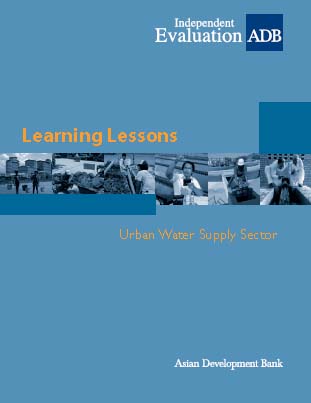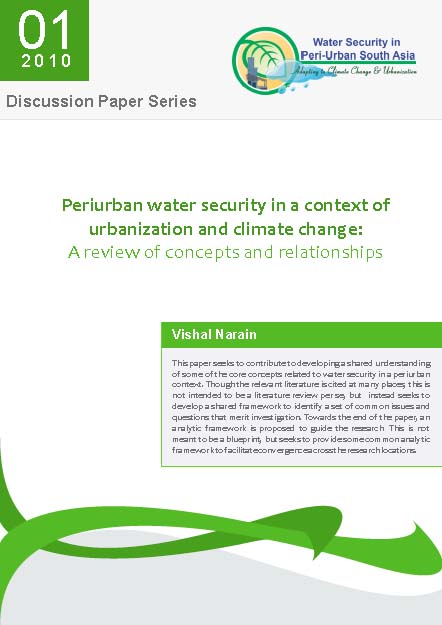/topics/urban-water
Urban Water
A citizen initiative to save Puttenahalli Lake in JP Nagar, Bangalore
Posted on 22 Jun, 2011 11:50 AMResidents of L&T South City and Brigade Millenium in JP Nagar, Bangalore formed a citizen initiative to save the neighbouring Puttenahalli Lake from becoming a dumping ground for construction debris and waste. A team from India Water Portal visited the lake in June 2011 to see the progress and challenges faced by such citizen initiatives.
Capacity and investment in the water supply and sanitation sectors - Guidelines in respect of participation of cooperative institutions (2006) - Water Supply and Sanitation Department (Government of Maharashtra)
Posted on 18 Jun, 2011 10:20 PMIt argues that this is because civil bodies are facing many problems due to urbanisation and increasing demand from the residents. There is a need to increase efficiency in the water supply and sewage.
Rainwater harvesting in urban areas of Karnataka (Government of Karnataka) - Draft policy (2006)
Posted on 18 Jun, 2011 10:16 PMThe Rainwater Harvesting Policy (2006) for Karnataka state has evolved out of the need for conserving rainwater and providing facilities for rainwater harvesting, in the context of the growing rate of urbanisation in the state and the rapid depletion of groundwater resources, leading to a water crisis.
The objective of the urban rainwater harvesting policy is to ensure that the available water is put to best possible use in the state by encouraging involvement of multiple level of stakeholders such as government and private institutions as well as citizens, in the appropriate management of rainwater.
Water Stories by talking history' - A series of films capturing water practices and rituals in Bangalore
Posted on 14 Jun, 2011 02:42 PMTalking History is an inter-collegiate course on Oral History offered at the Srishti School of Art, Design and Technology in Bangalore, India. The films were made between February - March 2011.
Doddabommasandra lake
Doddabommasandra lake is located close to B.E.L circle in an area called Doddabommasandra in Bangalore. This film endeavours to portray the story and memories of drying up of Doddabommasandra through two different viewpoints. The story reflects the pattern in which we are exploiting and losing our water resources.
A short film by Gautam Vishwanath and Kinshuk Surjan
Why Mumbai must reclaim its Mithi – A study by Observer Research Foundation
Posted on 08 Jun, 2011 05:05 PMThe river, along with its estuarine reach, provides the much-needed green lungs to the city in the form of mangroves. Neglect of this river was the main cause of the catastrophic floods in Mumbai on 26 July, 2005, which claimed nearly 1,000 lives. In what could be a monumental urban transformation initiative to be undertaken anywhere in India yet, ORF has proposed a grand vision for the reclamation of Mithi River. The study report and a documentary film ’Making the sewer a river again - Why Mumbai must reclaim its Mithi’ on the dreadful conditions of the river, was released in May, 2011 in Mumbai.
Decentralised sustainable approach to sewage and waste water treatment for urban India
Posted on 31 May, 2011 03:17 PMthe small ponds, the lakes, the rivers flows into backwaters, the sea, and the wells catching the abundant rain water enabling such vegetation and greenery all around……
Water – also the factor, which brings the biggest of problems to urban life –
- mosquitoes,
- bad stench from clogged dirty canals,
- floods and water logging especially in the monsoons,
- roads breaking up because of poor drainage,
- drinking water scarcity in many parts of the city,
- water borne diseases and health problems
Using the metro lines in Bangalore for rainwater harvesting - Article by S Vishwanath
Posted on 27 May, 2011 12:29 PMAs the elevated tracks come up over the city a mass transport network called the metro is being built all over the city. In phases it is likely to cover over a 100 kilometre and become one of the prime modes of transport to the city. Apart from the transport benefits it will bring to the city there is one other potential benefit that could accrue to the city due to its construction.
The metro rail track offers a tremendous potential for rainwater harvesting. A total length of about 45 kilometres and a width of about 12 metres mean that the endowment of rainwater on the relatively very clean track with Bangalore’s rains of 970 mm annually is about 523 million litres. Considering a coefficient of runoff of 0.90 the harvestable rainwater is around 471 million litres annually. This could provide about 13,000 people with their annual requirement of water at 100 litres per day. A substantial sum.
Urban water supply sector – Key lessons and contextual sector risks – A note by Asian Development Bank
Posted on 22 May, 2011 08:56 PM The note complements ADB’s Guidance Note on Urban Water Supply Sector Risk Assessment and offers a framework for mapping governance risks to inform the preparation of future country partnership strategies.
The note complements ADB’s Guidance Note on Urban Water Supply Sector Risk Assessment and offers a framework for mapping governance risks to inform the preparation of future country partnership strategies.
Such a framework covers institutional aspects (policy, legal framework, and regulation); organizational aspects (planning, financial management, procurement, and human resources); and sector operations. While the note has identified entry points for mapping risks to development effectiveness in the sector, lessons from evaluations can augment ongoing efforts for mitigating these risks at institutional, organizational, operational, and project levels; and enhance the development effectiveness of ADB assistance in the sector.
Bringing water to your door step - Urban water reforms for the next decade – A report by Price Waterhouse Coopers
Posted on 20 May, 2011 09:01 PM This report by Price Waterhouse Coopers India Limited for the Second Annual India Water Conference in April 2011 presents its view on urban water reforms for the next decade. India is still at an early stage of the urbanisation process and will witness exponential growth in many of its cities over the next few decades. By 2030 the urban population is expected to reach more than 590 million. This will put enormous pressure on all existing resources, especially water. Despite sufficient availability of raw water, many of its cities struggle to provide more than a few hours of water supply.
This report by Price Waterhouse Coopers India Limited for the Second Annual India Water Conference in April 2011 presents its view on urban water reforms for the next decade. India is still at an early stage of the urbanisation process and will witness exponential growth in many of its cities over the next few decades. By 2030 the urban population is expected to reach more than 590 million. This will put enormous pressure on all existing resources, especially water. Despite sufficient availability of raw water, many of its cities struggle to provide more than a few hours of water supply.
Improving water availability in the cities requires addressing complex policy, institutional and funding challenges. The core of the new approach will include instituting a new era of greater accountability and a performance-driven approach. Service delivery to urban poor has to be an integral part of this approach to bring about greater inclusiveness.
Recent experience with Public-Private-Partnerships (PPP) in urban water supply shows that with a customer focused approach and demonstration of clear benefits, there will be greater political and public acceptability of private participation. At the same time, fiscal framework at the local level has to be considerably strengthened before attempting wide scale replication of PPP.
Peri-urban water security in a context of urbanization and climate change - A review of concepts and relationships by SaciWaters
Posted on 17 May, 2011 04:05 PM
It is a part of the peri-urban water security project discussion paper series that aims at having a collection of research papers relevant to the concepts and processes involved in the project that represent preliminary ideas circulated to encourage discussion and comments.
Though the relevant literature is cited at many places, this is not intended to be a literature review per se, but instead seeks to develop a shared framework to identify a set of common issues and questions that merit investigation.
The paper argues that peri-urban can be better understood in terms of its characteristics - a mix of agricultural and non-agricultural land uses, flows of goods, services and resources between villages and urban centers and a social profile that is very heterogeneous and in a state of flux. All these impact upon the local natural resource base, creating particular environmental and natural resource management problems that are often beyond the scope of urban or rural governments alone and require innovative ways of being addressed.





